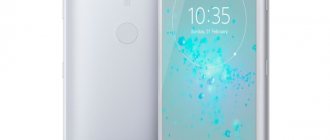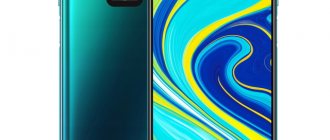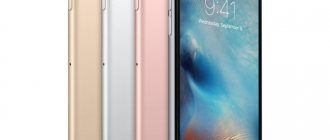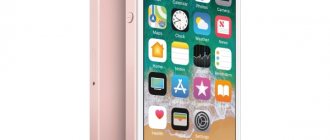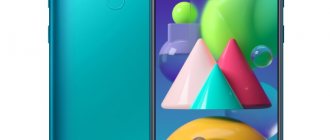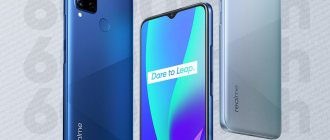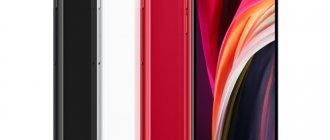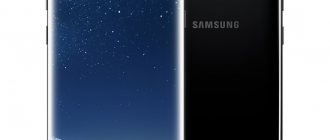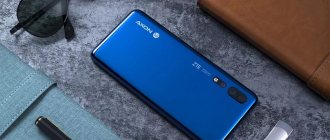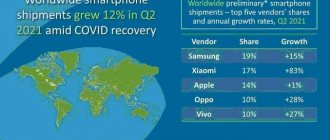Every year, smartphone manufacturers try to surprise their consumers with something. At one time, phones with color screens were a novelty for us, then with touch screens.
The fashion of the day is smartphones with flexible screens. Their advantages are the same as those of the famous push-button clamshells. This technology allows you to make gadgets more compact and also protect screens from mechanical damage.
Also, the displays of such smartphones are thinner and more durable. Owners of such phones do not need to purchase protective glass. Let's look at some models.
Samsung Galaxy Z Fold3 256Gb
Third generation Z Fold. The smartphone is still expensive, but it is becoming more and more reliable. For example, the external display and panel are covered with tempered Gorilla Glass Victus, and the frame is about 10% more durable than before. IPX8 water protection has appeared. The main flexible display received a new coating, whose wear resistance has increased by 80%, according to the creators.
The camera remains the same. And this is even good, because it takes better pictures due to new image processing algorithms, while the cost of the device itself has not increased.
The Qualcomm Snapdragon 888 chipset is responsible for performance. There is fast and wireless charging, stereo sound, and the battery capacity is 4400 mAh.
- Screen diagonal: 7.6+6.2 inches
- Screen resolution: 2208×1768
- Weight: 271 g
- Number of SIM cards: 2
- Processor: Qualcomm Snapdragon 888
- Memory capacity: 256 GB
- RAM capacity: 12 GB
- Battery capacity: 4400 mAh
- Rear camera: three modules 12/12/12 MP
- Front camera: 10 MP
- Memory card support: no
Samsung Galaxy Z Flip3 128Gb
The third-generation Galaxy Z Flip costs about the same as a regular flagship. Why not buy it, especially since the screen diagonal when open is as much as 6.7 inches? By the way, there is an additional 1.9-inch display on the front panel.
In this generation, the frame has become even stronger, the rear part of the case has a protective coating - Gorilla Glass Victus, and IPX8 water protection has appeared.
The processor used for all versions is Qualcomm Snapdragon 888. The battery capacity is expectedly not the largest - 3300 mAh, but there is fast and wireless charging. The dual camera shoots approximately at the level of the Galaxy S21, that is, this is a very high level of photography.
- Screen diagonal: 6.7 inches
- Screen resolution: 2640×1080
- Weight: 183 g
- Number of SIM cards: 2
- Processor: Qualcomm Snapdragon 888
- Memory capacity: 128 GB
- RAM capacity: 8 GB
- Battery capacity: 3300 mAh
- Rear camera: dual 12/12 MP
- Front camera: 10 MP
- Memory card support: no
Folding smartphones: gadgets of the future or innovation for the sake of hype?
Smartphones that are familiar to us in the form of a rectangular candy bar with a touch screen have been produced for the last 14 years. But technology does not stand still. Engineers, designers and marketers have repeatedly tried to bring a variety of innovations to the mobile device market. Among them are retractable cameras, handwriting input and drawing with a pen, modular designs similar to computer system units, etc.
The latest trend is folding smartphones. A team of experts from the M.Video-Eldorado Group studied the history of the creation of the first mobile phones with flexible screens, assessed the capabilities of current models and the prospects for the evolution of such devices.
Since the introduction of the first iPhone in 2007, the design of smartphones has remained virtually unchanged. The exception to these rules were only cosmetic changes, but the general paradigm remained the same: a large touch screen on the front panel, a front camera on the front (with or without cutouts), a main camera on the back and control keys on the sides.
Some engineers and designers began working on alternative form factors. And the most promising of the proposed options were devices with flexible screens. The ideologists of this concept believe that users should receive a universal device that allows it to turn into a compact smartphone for working “on the run” in some conditions, as well as a tablet that allows them to thoughtfully and happily enjoy multimedia content in others.
The first foldable smartphones began appearing in the form of real prototypes in the mid-2010s, but this was preceded by a series of concept devices. The development of this area is entirely related to screen production technologies. The first experiments used E-Ink displays on a polymer substrate. Later, OLED matrices began to be used for these purposes.
First prototypes
The closest attempt to release the first phone with a flexible screen took place in the late 2000s. At the MWC exhibition in 2006, the Dutch company Polymer Vision showed the Readius device, which was a hybrid of a phone and an e-reader. The gadget was equipped with a flexible E-Ink screen with a diagonal of 5 inches, which folded inside the body. When folded, the dimensions of the device were comparable to the typical dimensions of push-button telephones of that time. The device was powered by an ARM11 processor with a frequency of 400 MHz, a fairly powerful solution at that time, and had excellent battery life.
The main function of Readius was reading e-books. However, the device could work on 3G networks and had capabilities for viewing email and reading RSS feeds. It was also capable of playing music files, podcasts, audiobooks, and had several built-in games and even maps. Perhaps the main drawback of the new product was the inability to enter text.
Two years after the announcement, the company announced its readiness to begin shipping Readius, but the economic crisis of 2008 prevented these plans from coming true. As a result, in 2009 the company was sold for $17.7 million to the Taiwanese corporation Wistron. After this, the Readius project was finally closed.
The concept of a smartphone with a flexible screen was positively assessed by Nokia, HP and Samsung. However, mobile technology market players admitted that there are no technologies that could provide such a form factor. According to their forecasts, the first devices could appear no earlier than 2015-2017.
In 2010, Samsung showed the first color flexible display. The matrix size was 4.5 inches, and the resolution was 800x480 pixels. After that demonstration, it became clear that flexible displays would hit the market within a few years.
Next came a flexible E-Ink display developed by Human Media Lab. He wasn't just flexible. Sensors located in the screen monitored the degree of surface bending, producing an electrical signal as feedback.
In 2013, at CES, Samsung held a new demonstration of its developments in the field of flexible displays and created a real sensation. Really working samples of screens were shown, reminiscent in their structure of an OLED matrix, only instead of glass a special polymer film was used. It made it possible to make the screen flexible and at the same time provide it with very high bending strength.
LG also showed its analogue of a flexible screen at that exhibition. In addition, the company demonstrated quite functional gadgets. A little later, one of the technologies - a screen rounded at the edges, covered with ordinary glass - became part of the product line of many mobile equipment manufacturers.
Between 2013 and 2022, about a thousand startups were created around the world that were developing bendable and flexible displays. This boom eventually led to the emergence of actually working commercial products.
First commercial samples
The first commercial smartphones with flexible screens began appearing in 2022. By that time, the developments of Samsung, LG and numerous startups had already made it possible to establish the production of new types of displays. However, not one of them could boast of proper build quality and stability.
Thus, in January 2022, at the CES exhibition, a little-known Chinese startup Royole announced the imminent launch of sales of its flexible smartphone. The developers emphasized that they would release “the world’s first commercial phone” of this form factor. After a few months, the gadget could actually be bought.
When unfolded, this device was a 7.8-inch tablet with a screen resolution of 1920x1440 pixels, and when folded, it was a regular smartphone. Users who held the device in their hands spoke about a large number of shortcomings both in design and in terms of stability. Subsequently, the company released a new model, taking into account numerous comments.
In February, Samsung showed off its new product called Galaxy Fold. The developers took into account their 5 years of experience in creating flexible displays and numerous nuances that emerged during the development stage. The new gadget received a 7.3-inch screen that could be folded inside the case.
When folded, the device was a smartphone with an external 4.6-inch display. Samsung also said that it has adapted the Android operating system and the One UI custom shell to the transformable screen. The Google team, as well as third-party developers, were involved in the work.
The start of sales of the Galaxy Fold was scheduled for April 2022, the price of the phone was set at $1980. But these plans were not destined to come true. The reason for this is the reviews of journalists and bloggers who received mobile phones for testing just before the official release for sale. A large number of flaws were found in the design of the device. The biggest criticism was caused by the hinge, which, when unbent, lifted the protective film of the screen, under which large particles of dust immediately fell.
Attention was also drawn to the protective film on the display, which looked like a transport film, and when you tried to remove it, the matrix simply failed. It turned out that this was impossible to do. Samsung admitted its mistakes and began to fix them.
The company spent the entire summer fixing the problems. The hinge gaps at the top and bottom were closed. The base of the flexible display was reinforced, and the edges of the protective film were hidden under the screen frames so that it could not be removed. As a result, the updated Galaxy Fold went on sale only in September 2022. It reached Russia by October at a price of 160,000 rubles.
Huawei showed its version of a flexible smartphone in the spring of 2022. The device, running on Android 10, is called Mate X. Unlike Samsung's development, this mobile phone has a screen that folds onto the outer part of the body. Thus, when unfolded, the gadget had an 8-inch display, and when folded, it had two screens with a diagonal of 6.38 inches in front and 6.6 inches in the back. Thanks to the use of an ergonomic hinge, when folded the device was quite thin - only 11 mm. In 2020, a modified version of the smartphone called Huawei Mate Xs was announced.
At the end of the same 2022, the Motorola brand, which is a division of Lenovo, presented its version of a folding smartphone. The developers decided to focus on the design of the legendary folding phone from the 2000s, Motorola RAZR. The result was a device with a retro design, but with new functionality.
The device was equipped with a 6.2-inch flexible OLED display with a resolution of 2142x876 pixels, a Snapdragon 710 processor, 6 GB of RAM and 128 GB of internal memory. The weak point of the new product was the battery. The 2510 mAh battery could not provide long battery life. The phone had to be constantly charged.
At the beginning of 2022, Samsung announced another version of a flexible mobile phone. This time it was a Samsung Galaxy Z Flip flip phone, made in the style of the Motorola RAZR, but with a modern design. The display here folds in half horizontally, rather than vertically, as in the Galaxy Fold.
The device used a 6.7-inch flexible touch Dynamic AMOLED screen with a resolution of 2636x1080 pixels, as well as an external 1.1-inch display. Mindful of the difficulties with the release of its first folding phone, Samsung decided to completely redesign the folding hinge and strengthen the protective layer of the display itself. As a result, the matrix turned out to be more durable and practical due to the use of new materials.
In the summer of 2022, Samsung released the Samsung Galaxy Z Fold 2. The device retained the same form factor and similar design as the Galaxy Fold. However, the new product has a larger external screen - 6.2 inches. The size of the main AMOLED display was 7.6 inches. Like the Galaxy Z Flip, the Galaxy Z Fold 2 uses the same ultra-thin, durable glass.
The new product has become thinner and has a smaller gap between the displays. The new hinge features tiny bristles in what Samsung calls a "sweeper" that uses elastic fibers to remove dust and debris from the hinge, preventing damage to the display.
The performance of the flexible gadget is provided by the Qualcomm Snapdragon 865 Plus processor in tandem with 12 GB of RAM and 256 GB of internal memory. The battery capacity reaches 4500 mAh. 25W wired charging and 11W wireless charging are supported.
Microsoft has also outlined its vision of smartphones in a folding form factor. True, unlike Samsung, Huawei and Motorola, the developers did not bother with flexible displays, but decided to install several standard matrices. The first such device was the Microsoft Surface Duo.
This smartphone has two screens with a diagonal of 5.6 inches each. When unfolded, the gadget has an 8.1-inch display. The resolution of each panel is 1800x1350 pixels, the total is 2700x1800 pixels. Separately, Microsoft focuses on the ability to connect Windows 10 in the cloud using Windows Virtual Desktop. The device itself runs on Android 10.
From our review of the first generations of flexible smartphones, it becomes clear that all of them were, to one degree or another, a test of the pen and testing of technologies. The developers received feedback from customers and tried to take into account all the shortcomings in future new products.
Modern models of flexible smartphones
This year was marked by the emergence of smartphones with flexible screens of a new generation. Manufacturers managed to solve most of the “childhood diseases”, optimize the software for the folding form factor, and make the displays themselves more resistant to mechanical stress.
Huawei
At the beginning of 2022, Huawei announced the Mate X2 smartphone. The device is a folding device made without visible seams. The design ensures precise folding and compactness. A similar form factor is used in the Samsung Galaxy Fold family of smartphones. The high-strength steel frame and carbon fiber composite make the device lightweight yet durable.
A multi-component hinge is responsible for opening and closing the device, which engineers have been working on improving for more than five years. Thanks to the locking mechanism, the hinge creates a teardrop-shaped cavity around which the screen bends during folding. This allows the device to minimize crease on the outer screen when the device is unfolded.
The internal 8-inch display is made using OLED technology, it has a resolution of 2480 × 2200 pixels, a refresh rate of 90 Hz and a touch layer polling rate of 180 Hz. The surface of the screen is flexible; it bends when closing the device. On the outside there is a 6.45-inch OLED screen with a resolution of 2700 × 1160 pixels, an aspect ratio of 21:9, a refresh rate of 90 Hz and a response rate of 240 Hz.
The smartphone's performance is powered by a proprietary Kirin 9000 processor with eight cores clocked at up to 3.13 GHz, a Mali-G78 graphics accelerator and a 5G modem. The amount of RAM is 8 GB. The Huawei Mate X2 smartphone is equipped with a four-module Ultra Vision camera from Leica.
It includes a 50-megapixel ultra-sensitive wide-angle camera, a 16-megapixel module with ultra-wide-angle optics, a 12-megapixel telephoto unit with 3x zoom and optical stabilization, and an 8-megapixel module with 10x optical zoom and optical stabilization.
Power is supplied by a 4500 mAh battery with support for 55-watt charging. Dimensions are 161.8 × 74.6 (145.8 mm when opened) × 14.7 (8.2 mm when opened) mm, weight - 295 grams.
Samsung
In the summer, the Korean vendor introduced two devices with a flexible screen - Galaxy Z Fold3 5G and Galaxy Z Flip3 5G. The first smartphone, when folded, is similar in size to a regular smartphone with a 6.2-inch screen diagonal, and when unfolded, it is similar in size to a tablet with a 7.6-inch display.
The manufacturer claims that the main screen can withstand up to 200 thousand openings and closings. The display does not have a hole for the front camera that interferes with watching video. The main and secondary cameras operate in selfie, night, portrait and cinema modes.
The user interface is intuitive, reminiscent of working on a tablet or computer. The gadget is equipped with an electronic S Pen, which realistically simulates writing with a regular pen.
Flex mode splits the screen into two parts, with the top section allowing you to view content and the bottom section allowing you to take notes. On the big screen, you can open three applications at once and do several things at once. The smartphone has the necessary programs installed, additional ones can be found in Google Play and the Samsung brand store.
Among the features of the Galaxy Z Fold3 5G, users most often note that not all applications support landscape orientation. In addition, there is no fast or wireless charging function, there is no charger included, and when using two screens at the same time, the battery drains quickly.
The Samsung Galaxy Z Flip3, like its predecessor, is similar to the classic flip phones of the second half of the 2000s. Unlike the Fold version, it is small, lightweight, and fits in your pocket.
The smartphone is equipped with one flexible 6.7-inch AMOLED screen, two cameras: a main one with phase detection autofocus and an optical stabilizer, and a wide-angle one. The front camera is located in the middle of the screen at the top, like on standard mobile phones. The cameras have night mode and background blur. The display has a protective film that cannot be removed; it folds in the middle of the screen when the phone is open.
The device has a fairly tight hinge that allows you to secure it in any position. The fingerprint scanner is combined with the power button, and there is also a face unlock mode. There is 256 GB or 512 GB of internal memory for storing information; there is no slot for an additional memory card. The device is energy-intensive, the battery cannot maintain high autonomy, and the device gets very hot in the upper part of the case.
Motorola
This year, sales of the latest generation of flexible smartphone from Motorola called RAZR 5G begin in Russia. When folded, the smartphone looks like a classic clamshell; it is thin and compact. When opened, its internal screen has a diagonal of 6.2 inches. When the phone is folded, you can see notifications from instant messengers and email on the small external screen. The smartphone has two cameras: main and front.
When the screen is folded, the main camera becomes a front camera, which can be used to take selfies. There is 256 GB of internal memory for storing information, and 8 GB of RAM for fast application operation.
There is a fingerprint scanner on the back panel to identify the owner. Due to its compact size, it does not use the most capacious 2800 mAh battery, but it holds a charge for 24 hours, and with the help of fast charging, you can replenish the energy reserve for several more hours.
In the fall of 2022, another piece of news appeared in the media that Apple would introduce two smartphones with a flexible OLED screen in 2023. The project partner is LG. In one of these models, when folded, the upper and lower sides of the device touch each other (“clamshell”), in the second, the left and right sides (“book”) touch.
As for Russia, sales of the first smartphones with a flexible screen began in October 2022. To date, several tens of thousands of such devices have been sold throughout the country. According to our analysts, over the nine months of 2022, sales of folding mobile phones on the Russian market increased by 2.8 times in units and 2.4 times in money compared to last year.
According to experts, the popularization of foldable smartphones is hampered by the high price. It is impossible to solve the problem right now, since a lot of money has been invested in technology development, investments must be returned somehow, and devices are still being produced in very small batches. The second difficulty is the technical imperfection of the devices. Despite the manufacturer's assurances that the screen can be bent and unbent hundreds of thousands of times without harm, reality does not always confirm this. Flexible smartphones are inferior in reliability to conventional devices; they are more fragile and need to be taken better care of.
The third factor is demand uncertainty. For now, only geek enthusiasts are willing to pay a lot of money for unusual devices that, moreover, break. And if people don’t buy phones, the technology will remain unclaimed. The problem can be solved only by reducing the price and increasing reliability and conducting successful marketing campaigns.
Samsung Galaxy Z Fold2 256GB
The second generation of smartphone with a flexible screen from Samsung. And the most popular device among its peers.
The main difference from the previous generation model is the new hinge, which supports a huge number of openings and closings of the device. In addition, the additional screen has grown significantly in size.
Galaxy Z Fold2 is a flagship that runs on the Qualcomm Snapdragon 865 Plus chipset, the storage capacity is huge - 12 GB of RAM and 256 GB of ROM. Interestingly, the cameras here are a little simpler than those in the Galaxy Note 20 Ultra.
TCL Trifold (unknown)
In this list of the best foldable smartphones, we must mention the prototype manufactured by TCL with a unique design. The two loops unfold in opposite directions. The device folds into a narrow, thick strip and unfolds into a full-size tablet. The working prototype has not yet been shown, other details are also unknown. It will be interesting to see what a design like this can lead to.
As you can see, different manufacturers are trying to go in different directions in the still free market of flexible devices. If these devices become more sophisticated and their prices fall, users may consider purchasing.
futuredeveloper
https://opartnerke.ru/wp-content/uploads/2019/12/gibkie_smartfony_2019_royole_flexpai-500×262.jpg https://opartnerke.ru/wp-content/uploads/2019/12/gibkie_smartfony_2019_royole_flexpai-150×150. jpg2020-01-14T22:51:01+06:00 AlexanderSmartphones2019,2020New models from various companies such as Samsung and Motorola lead us to believe that flexible smartphones in 2019 will soon become widespread and popular. It will be interesting to see how the new form factor will attract buyers in the future. For now, we can discuss just a few models of smartphones that we saw in...AlexanderAlexander [email protected] Reviews of smartphones and Internet services
Samsung Galaxy Fold
The first generation Galaxy Fold can still be found on sale. And although it costs less than the more recent model, the price tag is still very high.
The diagonal of the main screen is almost as large - 7.3 inches, but the external screen is very small - only 4.6 inches diagonal. The chipset is Qualcomm Snapdragon 855, the memory capacity is 12 GB of RAM and 512 GB of ROM.
It's funny that the first versions of the model that fell into the hands of journalists broke down for many. Fortunately, after the device was put into production, no widespread problems were observed.
Samsung Galaxy Z Flip
Fold is a series for those who need a huge display. The Galaxy Z Flip isn't like that; it's essentially an Android-powered flip phone that's folded so small that it might go unnoticed in your pocket. And yes, it also uses a flexible display.
When opened, the Galaxy Z Flip looks like a regular Samsung smartphone from the front: screen, front camera. The main camera is located at the back. There is a small additional display - 1.1 inches diagonal. By the way, the diagonal of the main screen is 6.7 inches.
This is also a flagship model: Qualcomm Snapdragon 855 Plus chip, 8 GB of RAM and 256 GB of internal memory.
What is a flexible display
A flexible display has mechanical and functional features in which it not only displays complete, high-quality visual information, but is also able to change its shape.
The biggest problem faced by manufacturers of equipment and components is glass. The fact is that the 2 latest technological innovations in this area - OLED and AMOLED - will probably be replaced by a new product
Here are the types of screens that currently exist:
- LCD is the earliest and by now outdated technology that requires backlighting in order for the screen to glow.
- The operating principle of OLED is based on the use of light-emitting diodes and encapsulated glass. The top layer is made of a polarizer.
- AMOLED technology uses organic compounds that produce their own light. It does not use backlighting (like an LCD), which makes it possible to significantly simplify the production technology and make the screen flatter.
- FAMOLED technology assumes that the following layers are combined for the screen: a lower one made of TFT film, then organic-based diodes that produce light, that is, capable of self-luminescence, on top of them is a flexible encapsulated film made of several layers of polyethylene, replacing glass, and on top of it - polarizing layer to create a certain optical effect.
It was the replacement of glass with several layers of polyethylene film that allowed the screen of a smartphone, tablet or other equipment that uses the element to bend without affecting its own performance.
Microsoft Surface Duo 6/128GB
A very interesting device from Microsoft that works... Yes, based on Android, and not Windows, as one might assume.
The main feature is that it has two identical displays; the smartphone can be folded like a book. Moreover, you can open the halves completely and fold them. Individually, each display has a diagonal of 5.6 inches, and a total of 8.1 inches.
The smartphone is powered by a Qualcomm Snapdragon 855 processor, 6 GB of memory and 128 GB of ROM in the specified version.
Motorola Razr 2022
Motorola Razr 2022 is not officially supplied to the Russian market. It's a pity, the demand for this device would probably be quite good.
The Motorola Razr 2022 is a clamshell phone with a 6.2-inch diagonal flexible screen. There is also an external additional screen, and not the smallest one - 2.7 inches diagonal. Both screens are OLED.
The smartphone runs on Android 9, the chipset used is Qualcomm Snapdragon 710, the memory capacity is 6 GB of RAM and 128 GB of ROM.
Motorola Razr 5G
Motorola Razr 5G is based on the Razr 2022. The smartphones are very similar, but at the same time there are minor differences between them.
For example, the cameras in this version are much better, the battery capacity has been slightly increased, and the chip is the new Qualcomm Snapdragon 765G 5G with support for fifth-generation networks.
You can also note the new body colors.
Huawei Mate X
Huawei also presented a smartphone with a flexible screen, but it took a slightly different route: the screen seemed to envelop the outer surface of the smartphone, rather than hide inside. Interesting fact: when the device is unfolded, its thickness is only 5.4 mm!
As for the total screen diagonal, it reaches 8 inches. Huawei Mate X weighs 295 g.
The smartphone has a HiSilicon Kirin 980 processor and supports 5G networks. The battery capacity is good - 4500 mAh.
Choose your favorite foldable phone
So this was our list of the best foldable phones you can buy right now. As we went through the article, we can see that some of the foldable phones have been announced and these devices will be available commercially in the next few months. Additionally, some foldable phones are in the pipeline and you can expect an official launch early next year. However, one thing is clear: foldable phones will open up a new way to interact with smartphones, and we're really excited to try it out. But what do you think? Let us know your opinion in the comments section below.
79 / 100 Powered by Rank Math SEO
Post Views: 8,706
OPPO X 2022
The OPPO X 2022 only exists as a concept—for now. However, experts say that the smartphone will remain so.
OPPO X 2022 received a folding screen (stretchable), and to reduce or enlarge the screen, you need to swipe the touch side.
With this project, the company is showing what technologies it has in store.
Pros and cons of flexible displays
When creating bendable display technologies, manufacturers did not strive to improve picture quality. This happened a little earlier, when LED technology was used - an AMOLED screen, around 2013. Since then, gadget screens began to display images with full HD resolution. The pixel size has decreased so much that it can now only be seen under a microscope. That is why the picture quality is now reaching its maximum. And it seems that there would be no point in changing technologies further, but manufacturers began to build on other negative qualities of glass-covered monitors. First of all, this is fragility and relative size. But the thickness of the device is still an area of activity for which all manufacturers are fighting.
Now let's look at the advantages and disadvantages of bending screens in the form of a table:
| pros | Minuses |
| Reduced weight | Short service life |
| Thinner screen | The appearance of creases at bends |
| There is no risk of glass cracking when the gadget falls | Inability to reliably protect LED elements from moisture and other external negative factors |
| Compactness when folded, especially for large-sized equipment - televisions | Difficulty in some cases to achieve adequate software operation |
| Light weight |
